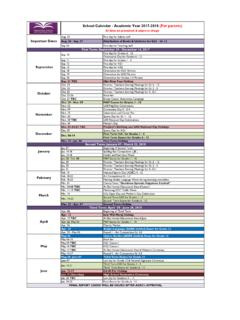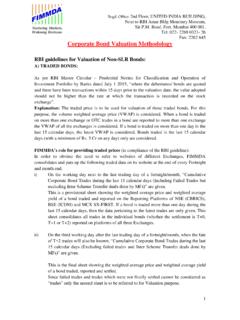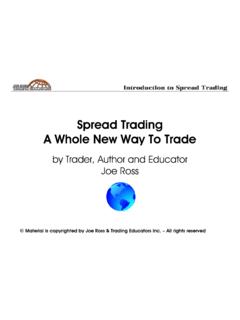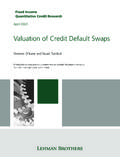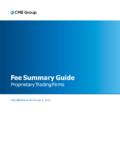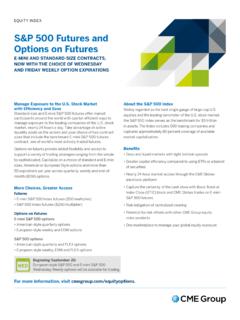Transcription of Options Probability Calculator Trading Guide
1 Options Probability Calculator Trading Guide Precision and Profits via Probability First Edition By Craig Severson 2 Options Probability Calculator Trading Guide Precision and Profits via Probability By Craig Severson Additional images courtesy of and Qcharts ( ). Copyright 2006 by Craig Severson All Rights Reserved No duplication or transmission of the material included within except through express written permission from the author, Be advised that all information is issued solely for informational purposes and is not to be construed as an offer to sell or the solicitation of an offer to buy, nor is it to be construed as a recommendation to buy, hold or sell (short or otherwise) any security.
2 The principals of, and those who provide contracted services for and Hampshire & Holloway LLC: - are neither registered Investment Advisors nor a Broker/Dealers and are not acting in any way to influence the purchase of any security - are not liable for any losses or damages, monetary or otherwise, that result from the content of any written materials, or any discussions - may own, buy, or sell securities provided in written materials or discussed - have not promised that you will earn a profit when or if your purchase/sell stocks, bonds, or Options .
3 You are urged to consult with your own independent financial advisors and/or broker before making an investment or Trading securities. Past performance may not be indicative of future performance. Securities provided in written materials or discussed are speculative with a high degree of volatility and risk. Opinions, analyses and information conveyed whether our own or based on sources believed to be reliable have been communicated in good faith, but no representation or warranty of any kind, expressed or implied, is made including but not limited to any representation or warranty concerning accuracy, completeness, correctness, timeliness or appropriateness.
4 We do not necessarily update such opinions, analysis or information. All information should be independently verified. All rights reserved. No duplication or transmission of the material included within except through express written permission from Hampshire & Holloway LLC, is a division of Hampshire & Holloway LLC, an Ohio Limited Liability Company. 3 Table Of Contents Probability Spread Example 1 Determining Which Strike Price to Sell in a Spread Example 2 Identifying a Probability Probability Long 11 12 4 Foreword If you ve picked up this Trading Guide , chances are you ve been Trading for at least a few months, with varied success in stocks and Options trades.
5 You ve learned how to buy stocks, puts, calls, and even place multiple-position Options spreads. You ve learned some technical analysis, and your winning percentage and returns are rising. You re not consistently profitable, though. You still make arbitrary decisions about what strike prices to place your Options spread trades at, and you re never really sure whether your trades are risky or conservative. If you get into a long call position, you re not sure where to take your profits at. You need to bring some objective data to your trades, such as Probability Analysis via Implied Volatility!
6 Probability Analysis? Implied Volatility? Whazzat? If you ve been following the newsletter for any length of time, you ll see the editors refer to current positions with terminology such as XXX is 50 points out of the money with a 92% Probability of winning the trade . These numbers are actually calculated by manipulating the Black-Scholes Options pricing formula to extract Probability . Since volatility is defined as one standard deviation of the natural logarithm of the price change of an asset (annualized), if we already know the Implied Volatility of the asset and the Options price, then we can solve for the missing variable Probability .
7 Right about now, your eyeballs should be rolling back into your forehead. Don t worry this is a Guide on Application, not Theory. All the mathematicians have done the hard work; all you have to do is learn to use the tool to start applying more Precision and Profits to your Trading ! Let s dive right into applications, starting with Spread Trades! 5 Probability Spread Trades When you set up an Options credit spread, this usually involves the selling of one strike price, and the buying of the next strike price out of the money.
8 Your sold strike is a line in the sand that must not be crossed for you to attain maximum profitability. How far out should that strike price be? What will be your Probability of winning that trade after you enter it? How can you objectively balance your need for a decent return, without taking on undue risk? Let s go through our first example to see how we would use the Calculator to determine these answers: Example 1 Determining Which Strike Price to Sell in a Spread Trade For the following chart, we ve determined that we d like to set up a bearish credit spread; we will sell to open a call option out of the money, and buy to open a call option further out of the money: Figure 1 Where should we place our sold strike?
9 To answer this question, we need to know three things: 1. The current stock price 2. The current Implied Volatility of the ATM call Options on this stock 3. The number of calendar days to expiration 6 Since we know that the number of calendar days to expiration is 25 (yes, you count weekends too!), and we know from the chart above that the current stock price is , all we need to know is what the Implied Volatility is for the At-The-Money calls for this stock. For that, we go to the website of the Chicago Board of Options Exchange, or the CBOE: At the main page, we will select the Trading Tools tab, the Volatility Optimizer selection, and finally the IV Index.
10 This is what we ll see at that page. The upper left corner of the screen near the yellow box is where we ll enter our ticker symbol, which automatically defaults to SPX for the S&P 500 index. The red oval is where our target information is located: Figure 2 7 Zooming in on the red oval, here s the information that we re after: Figure 3 We can see that the Implied Volatility of the Calls is So now we have everything that we need to calculate Probability , and select our strike prices: 1. The current stock price = 2.

